‘A Tremendous Relief’ : Town Finally Getting Rid of Uranium Tailings
- Share via
LAKEVIEW, Ore. — Even with the huge yellow earth movers parked nearby, it’s hard for Sally Bourgeois to believe that this 30-acre pile of uranium mill tailings is finally headed for a clay-lined grave where she won’t have to worry about it anymore.
“Six months ago, I wouldn’t have bet a lot of money on it,” she said after ceremonial shovelfuls of dirt were pitched into a big front loader to mark the beginning of the $14-million cleanup project. “It’s going to be a tremendous relief--like having a quarantine lifted.”
Bourgeois moved to this town of 2,800 people from the Eugene area 17 years ago with her husband, an optometrist who loves to hunt in the big high-desert country of southeastern Oregon. They reared three children here.
“We lived here a long time before we realized the wastes were even here,” she said. “I was aware things blew up on Goldmohr Terrace. We would watch those clouds rise off the tailings pile before it was covered and it would move around the community.”
Friends Died From Cancer
Over the years she saw friends who had never smoked die from lung cancer and last spring her husband was diagnosed of leukemia.
“I lost many friends to cancer--enough to raise the question in my mind,” she said.
Helping to form the Radiation Education Council in 1979, she took on the painful job of getting through to her friends and neighbors that they had a serious problem lying on the edge of town.
Starting Sept. 1, contractors will start hauling what amounts to 22,100 truckloads of tailings and contaminated dirt from a field behind the Precision Pine sawmill.
Left over from Oregon’s first uranium strike, back in the days when nuclear energy was embraced rather than feared, the low-level radioactive wastes are headed for a spot far from people and water, on a ranch seven miles to the northeast.
The tailings and contaminated dirt will be put in a pit lined with two feet of clay, then capped with another two-foot clay liner and two feet of dirt and rock. When it’s done, the embankment will be as much as 70 feet high and cover an area as big as 10 football fields.
“It is a site we can stabilize to last 1,000 years,” said Felix Miera, the Oregon Department of Energy’s project representative.
Of 24 uranium mill tailings sites around the country that Congress authorized for cleanup in 1978, Lakeview is just the fourth to get started. The job is supposed to be done by the end of November, 1987.
The project was the subject of two lawsuits and moved through at least 10 agencies ranging from the U.S. Nuclear Regulatory Commission to the Lake County Planning Commission.
“My father found the White King Mine in 1955,” recalled Gordon Tracy, who worked as an engineer in the aluminum industry before coming home to Lakeview 10 years ago and becoming administrative assistant to the Lake County Board of Commissioners.
“At that point in time, uranium was patriotic,” said Tracy. “A lot of people wanted to come to the mine to sit on the uranium ore. As a kid I think I heard it was for arthritis.”
The Lakeview Mining Co. was formed and the mine went into production in 1959, selling processed uranium ore to the Atomic Energy Commission until it ran into production and financial problems and shut down in 1961.
The ore was trucked from the Warner Mountains to the mill, which was built on the northern edge of town to take advantage of the heat from the geothermal springs that also served a neighboring health spa.
“What made it unique here is they used geothermal energy to leach the ore,” said Tracy. “The heat speeded things up. That’s probably the biggest reason we had the mill on the edge of town. That’s the same reason we’ve got to move it. Ironic, isn’t it?”
The danger from dust contaminated by radiation and other hazardous materials blowing off the tailings pile ended in 1976, when two feet of dirt was dumped on the pile.
“We never worried about them,” Tracy said of the tailings. “Before that, the complaints were about the dust, the way it was flying around.
“There are those people still, die-hards out there, who think the government is wasting their money.”
But in 1984, the fears were resurrected when studies revealed that an earthquake fault running through the site made it possible for hazardous materials to leach into groundwater and a nearby creek.
“The radioactivity hasn’t percolated into the groundwater yet, but the sulfuric acids have,” said Bourgeois. “We know the radioactivity is coming behind it. So this is very timely.”
Built on the cattle and timber industries, Lakeview has had to scratch hard to keep from blowing away as beef and lumber prices plummeted in recent years, and the tailings weren’t helping efforts to attract tourists, retirees and new industry.
“I had a call the other day from a state policeman being relocated to Lakeview,” Tracy said. “He wanted to know how dangerous it is. I believe with the moving of the tailings we will be out of that stigma.”
More to Read
Sign up for Essential California
The most important California stories and recommendations in your inbox every morning.
You may occasionally receive promotional content from the Los Angeles Times.













